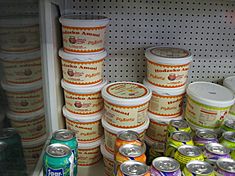Amasi facts for kids

Amasi in a supermarket fridge
|
|
| Nutritional value per 100g | |
|---|---|
|
5 g
|
|
| Sugars | 0 g |
| Dietary fiber | 0 g |
|
4.4 g
|
|
| Saturated | 2.7 g |
|
Protein
|
3.7 g
|
| Minerals | Quantity
%DV†
|
| Sodium |
3%
47 mg |
| Other constituents | Quantity |
| Cholesterol | 9 mg |
| †Percentages estimated using US recommendations for adults. Source: https://world.openfoodfacts.org/product/6001391000239/amasi |
|
Amasi is a popular food in South Africa and Lesotho. It is a type of fermented milk that tastes a bit like cottage cheese or plain yogurt. People in different regions call it by different names. In Zulu and Xhosa, it's called Amasi. In Afrikaans, it's maas, and in Sesotho, it's mafi.
Contents
How Amasi Is Made
Traditionally, Amasi is made in a simple way. People put fresh, unpasteurised cow's milk into a special container. This container can be a calabash (a type of dried gourd) called iselwa in Xhosa or igula in Zulu. Sometimes, a hide sack is used instead.
The milk is left to sit and ferment. This means tiny helpful germs (bacteria) in the milk turn its sugars into acids. As the milk ferments, it separates. A watery liquid called umlaza forms, and the thicker part becomes Amasi.
This thick Amasi is often poured over a type of corn porridge called pap (or umphokoqo in Xhosa). Traditionally, Amasi is served in a clay pot called ukhamba (Zulu) and eaten with wooden spoons. You can also just drink it. Today, Amasi is also made in factories using special bacteria called Lactococcus lactis.
Amasi in Culture
Amasi is more than just food; it's an important part of the culture for many people in Southern Africa.
Zulu Traditions
For the Zulu, Amasi is believed to make a person strong and healthy. It's a very respected food. If someone has been near death, they traditionally avoid eating Amasi for a while. Fresh milk is rarely drunk on its own. Instead, it's sometimes used to make Amasi thinner if it's too thick.
Amasi in South Africa
Amasi is well-known throughout South Africa. Even Nelson Mandela once mentioned it. When he was trying to stay hidden from the government during apartheid, he overheard two Zulu workers talking. They were surprised to see milk left out to ferment on a windowsill. This was unusual because white people at the time rarely drank Amasi. This small detail made him realize he needed to be extra careful about his hiding place.
Amasi is also used in the cooking of South African Indian communities. They use it in ways similar to how curd (another fermented milk product) is used.
Xhosa Traditions
In the Xhosa culture, Amasi plays a special role in welcoming a new bride. As a sign of being accepted into her new family, the bride is served Amasi along with a piece of meat called uTsiki.
See also
 In Spanish: Amasi para niños
In Spanish: Amasi para niños

